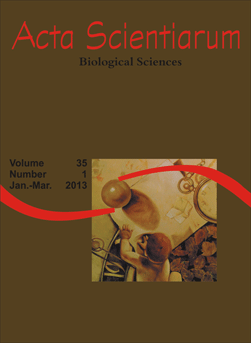<b>Genetic relationship among <i>Camponotus rufipes</i> Fabricius (Hymenoptera: Formicidae) nests by RAPD molecular markers</b> - doi: 10.4025/actascibiolsci.v35i1.10913
Resumo
Random amplified polymorphic DNA (RAPD) markers were used to investigate the genetic relationship among nests of the carpenter ant, Camponotus rufipes, located in the same area. Five random oligodecamers were used to amplify DNA from 108 ant workers collected from six nests. A total of 47 RAPD markers were identified, which revealed low levels of genetic differentiation among nests (Fst = 0.00218) and a low average Shannon index (0.3727) among workers within nests. These results together suggest that the C. rufipes nest may be formed by a single, once-mated queen and that nests produced by queens that are genetically related tend to keep their nests in close proximity to one other.
Downloads
DECLARAÇÃO DE ORIGINALIDADE E DIREITOS AUTORAIS
Declaro que o presente artigo é original, não tendo sido submetido à publicação em qualquer outro periódico nacional ou internacional, quer seja em parte ou em sua totalidade.
Os direitos autorais pertencem exclusivamente aos autores. Os direitos de licenciamento utilizados pelo periódico é a licença Creative Commons Attribution 4.0 (CC BY 4.0): são permitidos o compartilhamento (cópia e distribuição do material em qualqer meio ou formato) e adaptação (remix, transformação e criação de material a partir do conteúdo assim licenciado para quaisquer fins, inclusive comerciais.
Recomenda-se a leitura desse link para maiores informações sobre o tema: fornecimento de créditos e referências de forma correta, entre outros detalhes cruciais para uso adequado do material licenciado.












1.png)




3.png)













